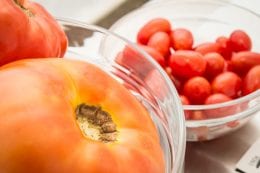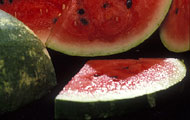A recent foodborne illness outbreak occurred in northeast Kansas due to contaminated fresh tomatoes served at a church supper. Preliminary investigation results report 69 illnesses and 14 of those tested positive for Salmonella Newport. The tomatoes came from multiple sources so an environmental assessment is underway to determine the contamination source.
Salmonella Newport is the third most implicated microorganism in U.S. foodborne illness outbreaks. It tends to survive in extreme conditions such as low relative humidity, high temperature, and UV exposure. It also tends to survive on the skin surface of tomatoes. It can also become internal during plant growth as it could come from contaminated water and soil.
Therefore, care in handling fresh tomatoes from farm to fork is important. In the kitchen, take care in preventing cross contamination during tomato preparation by keeping surfaces and utensils clean and sanitized. All cut tomatoes should be stored in the refrigerator within two hours. Always wash your hands before and after handling any food as dirty hands are a significant source of foodborne illness.
Source: J. of Food Protection, Vol. 81, No. 7, 2018, pp. 1193-1213


